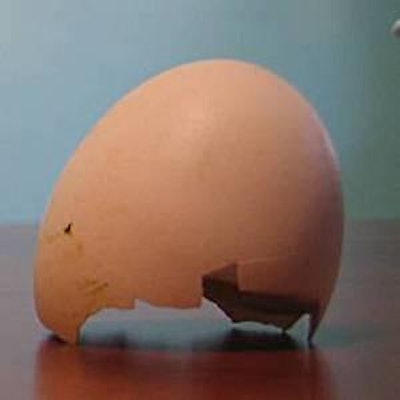
The human touch still plays an important role in successfully achieving a consistent output of quality day-old chicks. This idea was included in a recent Aviagen Production Management School Module, held in Amsterdam, which looked at the knowledge and skills needed to achieve optimum hatchery performance, thus producing a bird with the best start in life.
Among simple checks to ensure the quality of day-old chicks are calculating meconium score and regulating air temperature.
Meconium score
If chicks are held in the hatcher for too long, they will not grow as well once they reach the broiler house. A simple way to tell if this is happening is to check how many of the eggs in a hatcher basket are stained with meconium – the dark green first droppings of the chick.
Checking the score is useful, easy to do and, once known, allows corrective action to be taken if necessary.
To check the score, the five dirtiest eggs need to be taken from each of the five hatcher trays per flock. These should be taken at the chick take-off.
The collected eggs can be checked by using the five-point scale shown here.
If the dirtiest eggs are most closely associated with images four or five in the scale, set the eggs three hours later and check the flock in three weeks' time.
Should all the eggs be clean, check that the total incubation time is not too short. This would be indicated by wet chicks in each hatcher basket and, if very short, live pipped embryos.
If meconium scores vary from tray to tray, there may be some variability in temperatures across the setter, and advice should be sought to correct this.
Every hatch should be checked in this way as flock age, egg age and the season can all affect total incubation time.
Temperature
Body temperature is not easy to regulate for the newly hatched chick, and so it is worth remembering that air temperature, humidity and air speed will all affect its comfort. It is relatively easy to lend the chick a helping hand, but first you need to ascertain whether the ambient temperature is too high or too low.
So how do you know if air conditions are correct?
Observing chick behavior is a quick and easy indicator, as chicks that are too hot are noisy and pant, while those that are cold will huddle together to keep warm. In addition, the legs or feet of chicks that are not warm enough will be cold to the touch.
In a recent trial, an Aviagen hatchery specialist team showed that chicks which were panting had a high vent temperature, averaging 106F, while comfortable chicks had a vent temperature that averaged 104F.
Importantly, when the two groups were held in the hatchery for 12 hours, the overheated chicks lost nearly twice as much weight as those chicks in the comfortable atmosphere.
However, temperature at the hatchery can lead to long-term performance issues. Samples taken at the hatchery revealed that chicks that had been overheated had slight gut damage, making it harder for them to absorb nutrients.
When these chicks were grown in a broiler trial, they were 60 g lighter at 35 days than chicks that had been held in comfortable conditions.
To ensure that chick holding conditions are optimal, keep a close eye on their behavior during processing and holding to make sure that they are calm and well spread out in the chick boxes and not gasping, meaning that they are too hot, or huddling from being too cold.



![Dr. Ashley Peterson, vice president of scientific and regulatory affairs, National Chicken Council, said, “They [USDA] didn’t collect enough samples to separate out the parts statistically. In my mind, they should have run another six months so we could have had a performance standard for individual parts.”](https://img.wattagnet.com/files/base/wattglobalmedia/all/image/2015/04/an.Ashley-Peterson-1305USAfoodsafety.jpg?auto=format%2Ccompress&fit=crop&h=167&q=70&w=250)













